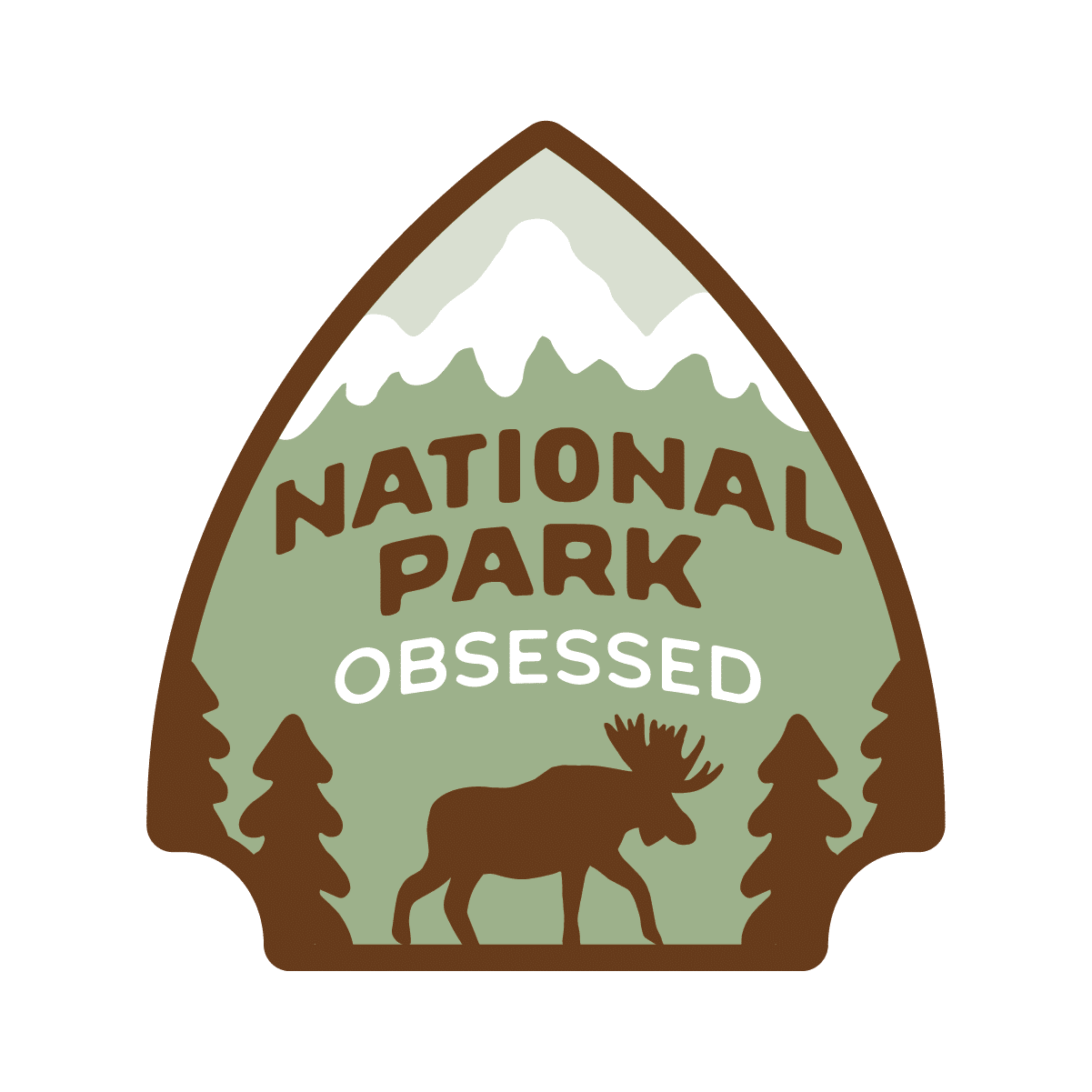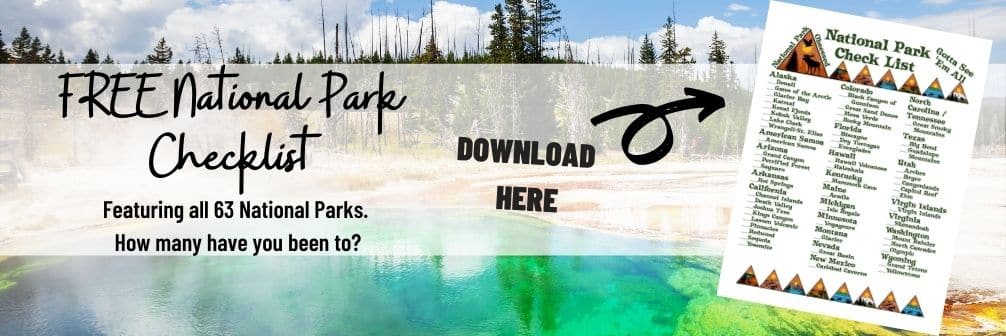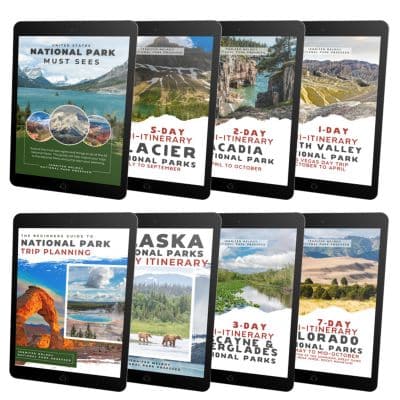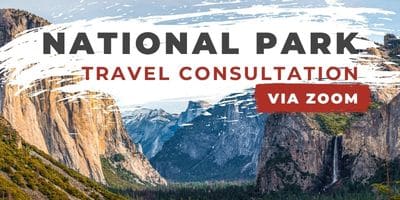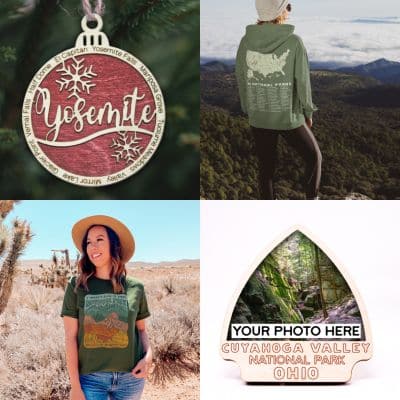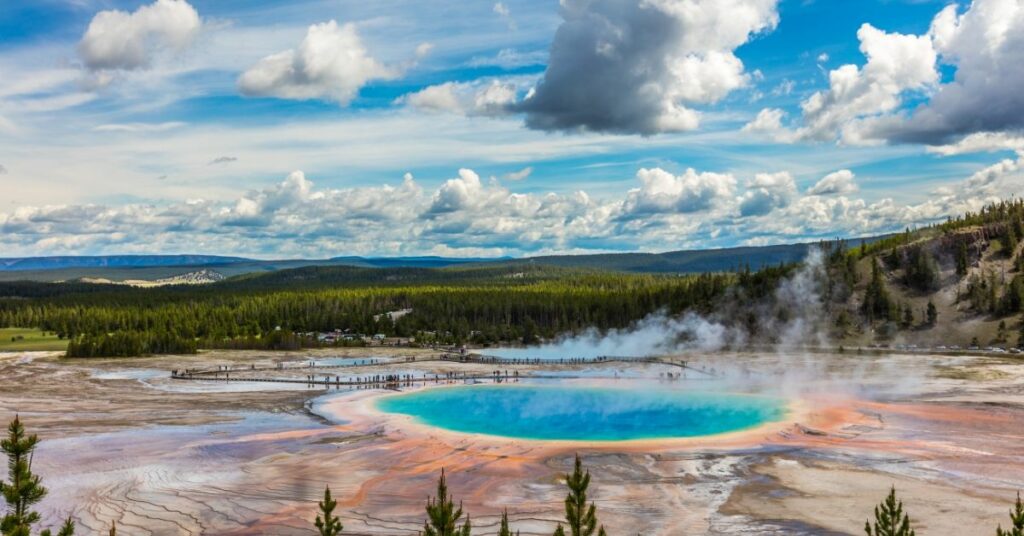
15 Amazing National Parks for Non-Hikers
- Jennifer Melroy
- Last Modified September 3, 2021
- First Published on July 18, 2020
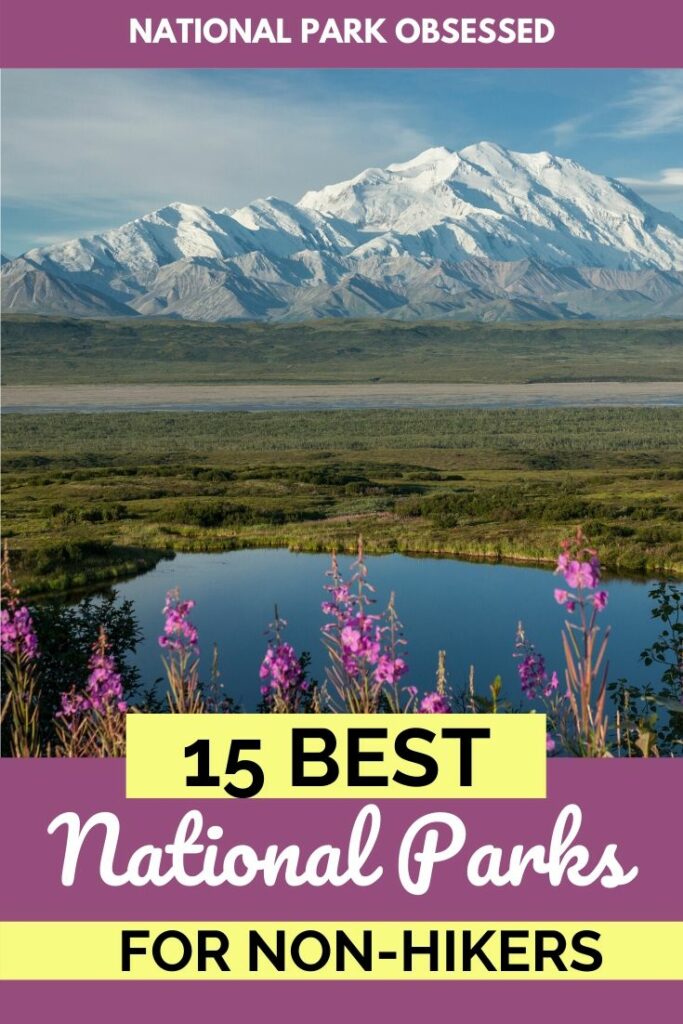
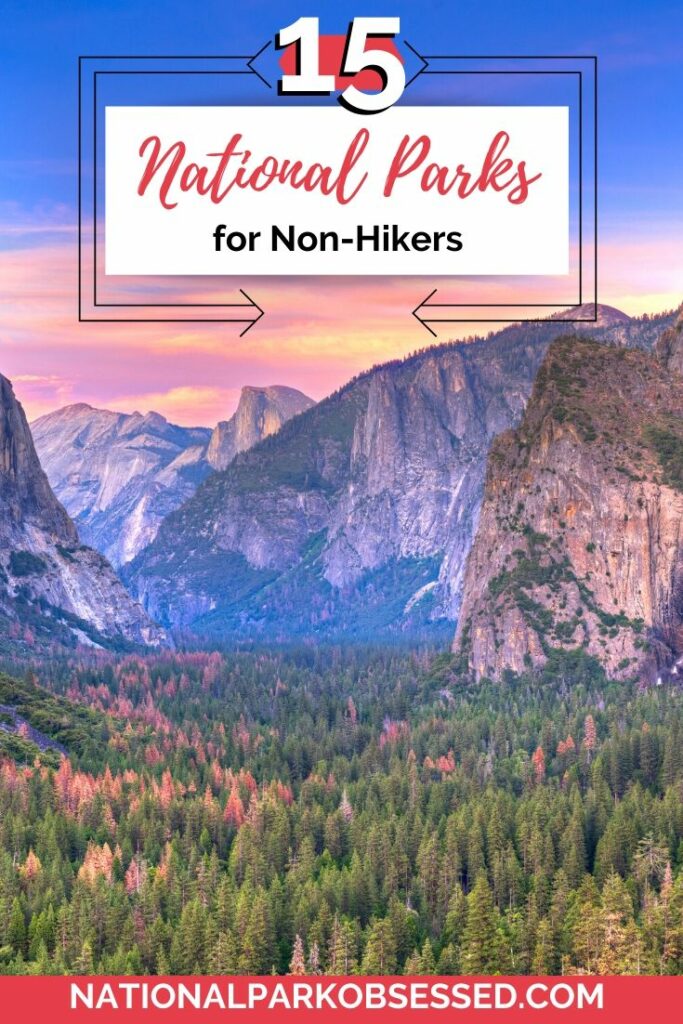
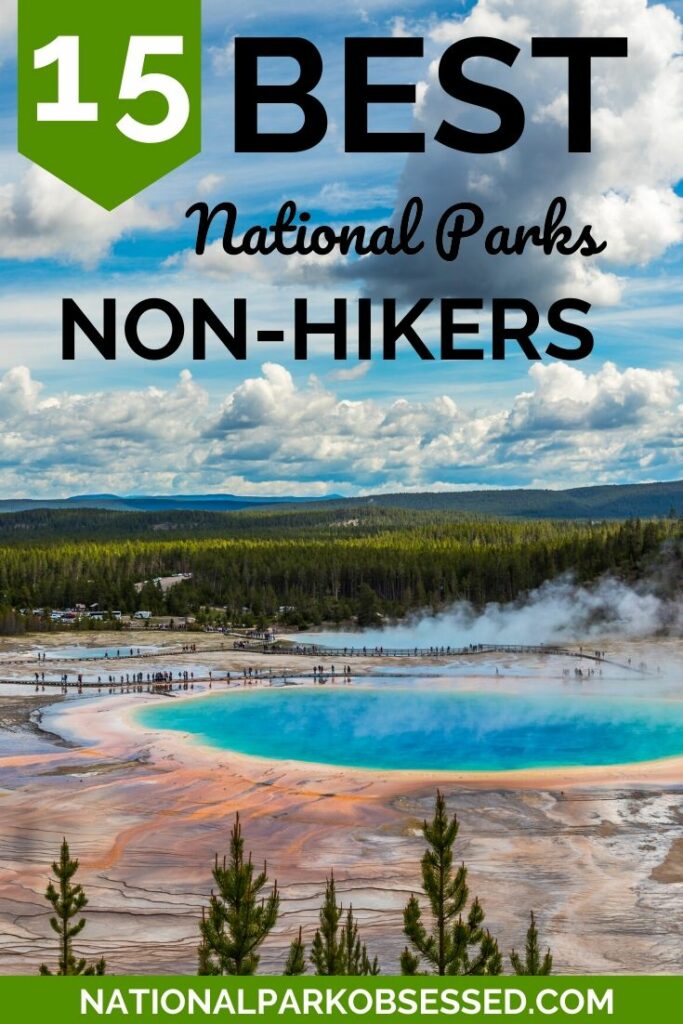
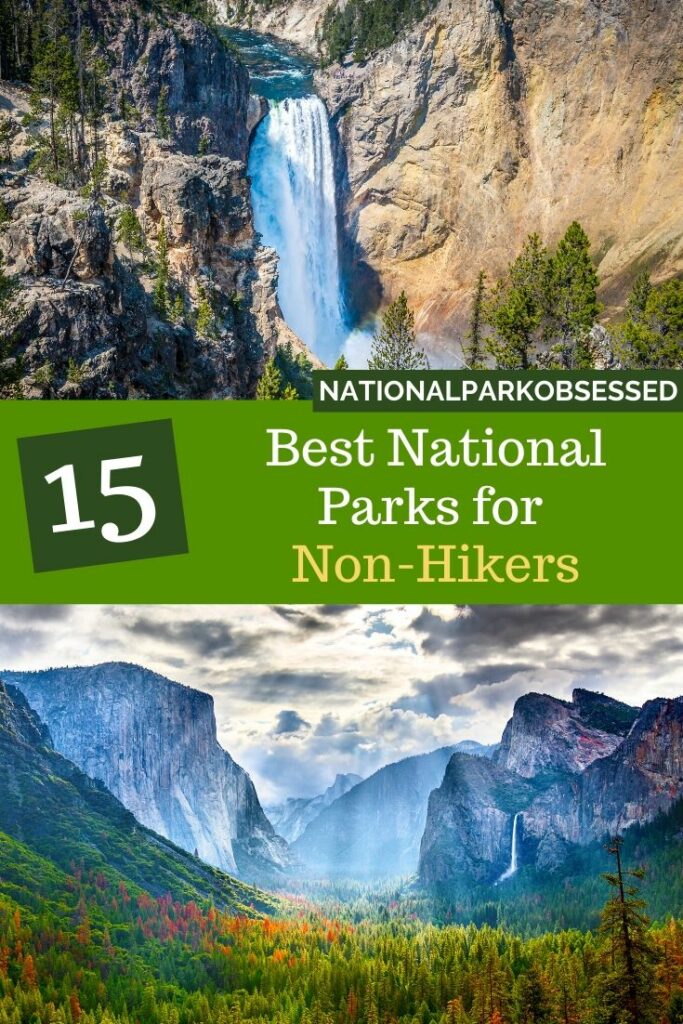
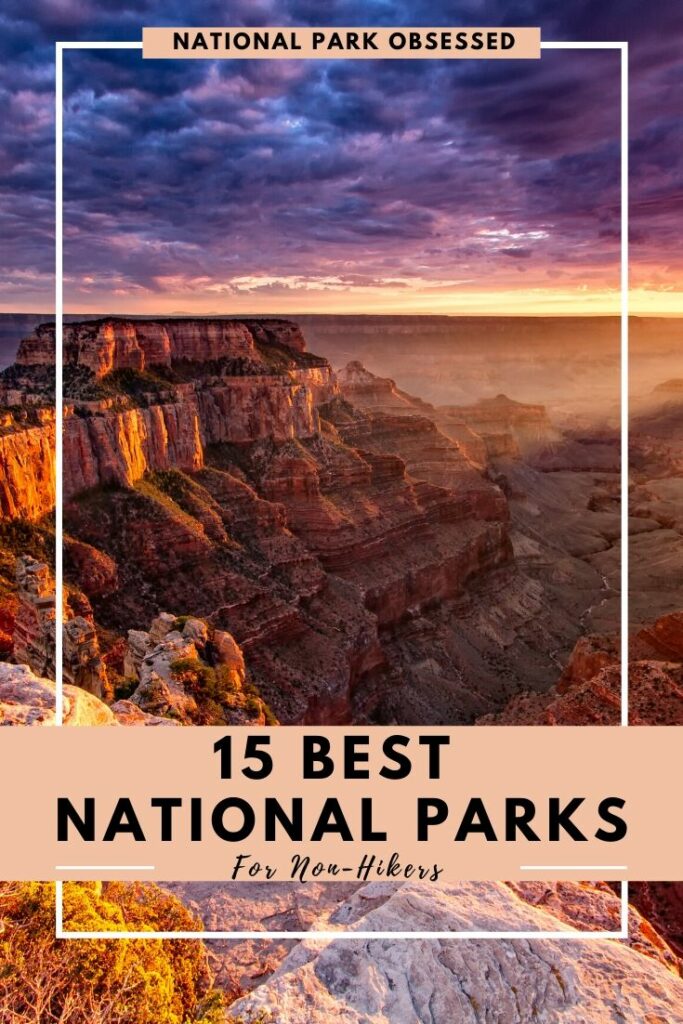
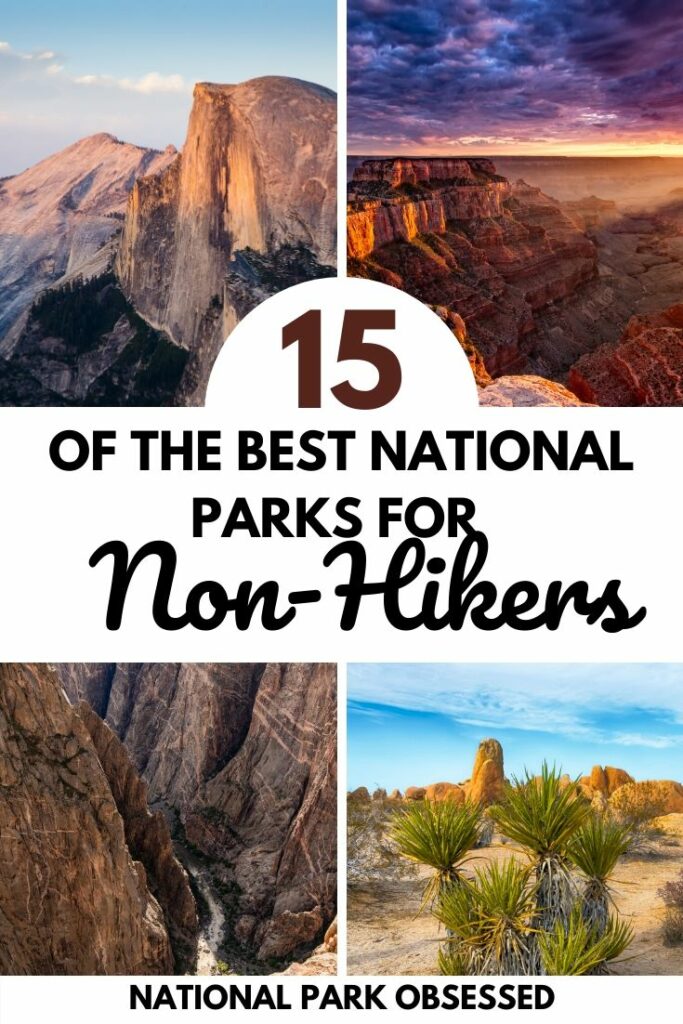

Peak-baggers, hikeaholics, or trail bums. No matter what they call themselves chances are you’ve run into more than your fair share of hiking enthusiasts if you’ve ever set foot inside any one of the 63 National Parks that are spread throughout our nation. While the vast majority you will meet are contentious and amiable, there are definitely a small number who saunter through the park as if they are a cut above the rest of us because of trail dust they’ve collected on the soles of their boots. However, true national park enthusiasts know that you don’t have to be a mile monger in order to enjoy America’s best idea.
National parks are spaces that have been reserved for the enjoyment of all Americans. No matter who you are or how you choose to enjoy the outdoors, there are adventures and activities for you. National parks are supposed to be accessible to us all, and thanks to development programs like the Civilian Conservation Corps and Mission 66 they are more accessible than ever. National parks are not spaces exclusively reserved for hikers. Some of them are arguably better suited for those who prefer short walks or other forms of touring.
If you happen to be a non-hiker then this article is for you. We’ve compiled a list of 15 parks that are perfect for non-hikers or people who enjoy driving, swimming, snorkeling, or strolling their way through a park trip. If you fall into any of these categories, then you’ll enjoy this list of national parks for non-hikers.
Please note that while this guide is about national parks for non-hikers, this is a guide is geared towards individuals looking to explore the parks but are choosing not to hike. If you are an individual with a disability and are looking for first-hand knowledge of the actual accessible national parks, I suggest checking out Curb Free with Cory Lee. He has explored several national parks and is an amazing resource. Check out his guide to the Great Smoky Mountains here.
- Map of National Parks for Non-Hikers
- Best National Parks for Non-Hikers
- Black Canyon of the Gunnison National Park, Colorado
- Bryce Canyon National Park, Utah
- Crater Lake National Park, Oregon
- Cuyahoga Valley National Park, Ohio
- Denali National Park, Alaska
- Dry Tortugas National Park, Florida
- Grand Canyon National Park, Arizona
- Great Smoky Mountains National Park, North Carolina/Tennessee
- Hot Springs National Park, Arkansas
- Joshua Tree National Park, California
- Petrified Forest National Park, Arizona
- Shenandoah National Park, Virginia
- Theodore Roosevelt National Park, North Dakota
- Yellowstone National Park, Wyoming/Montana/Idaho
- Yosemite National Park, California
- Pin to Share: 15 Amazing National Parks for Non-Hikers
This post may contain affiliate links, meaning if you book or buy something through one of these links, I may earn a small commission at no extra cost to you! Read the full disclosure policy here

Map of National Parks for Non-Hikers
[show-map id=”95″]
Best National Parks for Non-Hikers
Black Canyon of the Gunnison National Park, Colorado
Black Canyon of the Gunnison National Park is one of the most car-friendly parks you will find. There are plenty of opportunities to pull off the parks South Rim Road and enjoy breathtaking views of the canyon that only require a walk of a few yards at most. The canyon’s most iconic features like the famous twin dragons on the Painted Wall. Black Canyon of the Gunnison is also one of the best parks for birding, and it’s flat topography make it ideal for people who just want to try and spot some of the many species of birds that make their homes nesting in the canyon walls.
Best Time to Visit Black Canyon of the Gunnison: April to October
How to get to Black Canyon of the Gunnison: Black Canyon has a north and south rim. They are not connected. You have to drive around the canyon. The South Rim is located off CO 347 from the intersection with U.S. Highway 50 east of Montrose.
Black Canyon of the Gunnison Entrance Fee: $25.00
Black Canyon of the Gunnison Official Website: Click Here
Map of Black Canyon of the Gunnison: Download
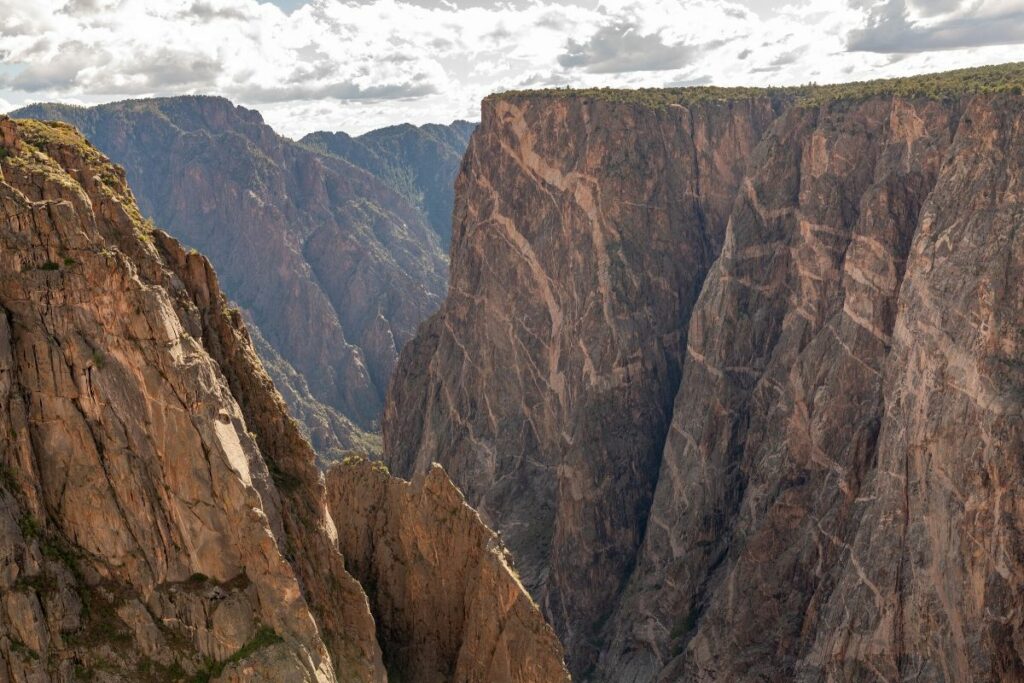
Bryce Canyon National Park, Utah
Bryce Canyon National Park is home to one of the most amazing examples of erosion that you can view. The spectacular Hoodoo formations and color palette make this a park well worth a visit, even for the non-hiker. Bryce Canyon, like many other canyons, can be enjoyed from the very level Rim Trail walkway that skirts the edge of the canyon, giving you plenty of amazing views with minimal effort. Most of the best viewpoints in the Ampitherather area can be seen from this viewpoint which also connects you to stores and interactive activities. Many people would agree that to really enjoy all that Bryce Canyon has to offer, you have to get down into the canyon which involves a lot of steps along steep and winding trails. But why not let one of the parks trust horses do the hiking for you? 2-4 hour guided tours of the Amphitheater area from horseback are available, allowing you the full Bryce Canyon experience while sparing you from becoming footsore.
Best Time to Visit Bryce Canyon: May to September
How to get to Bryce Canyon: Bryce Canyon is located off UT Route 12. It can be reached via I-15 and US 89.
Bryce Canyon Entrance Fee: $30
Bryce Canyon Official Website: Click Here
Map of Bryce Canyon: Download
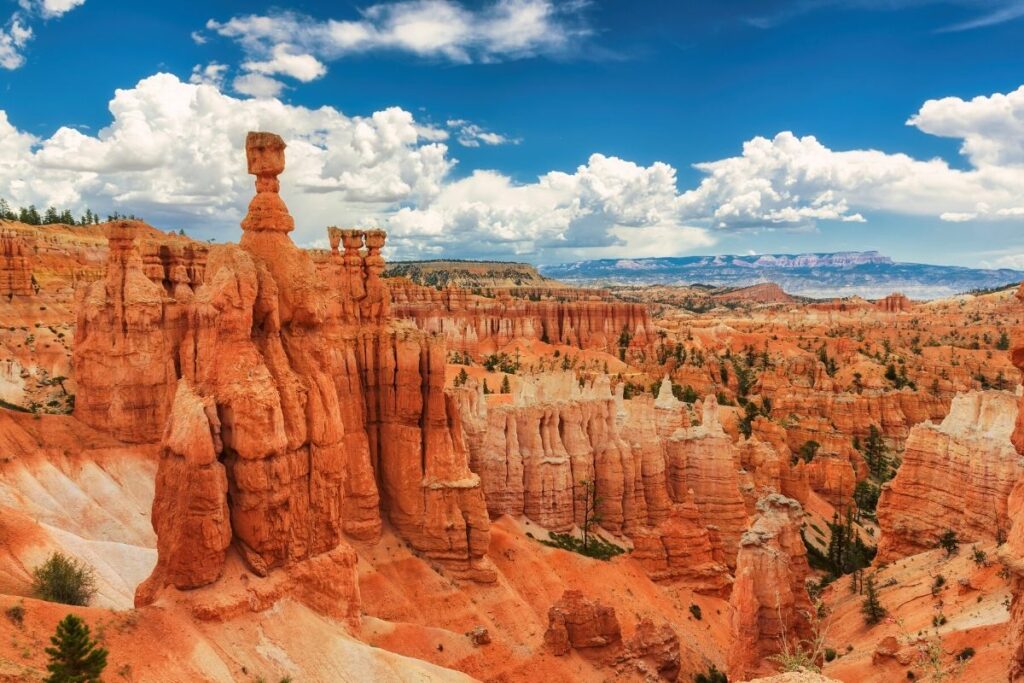
Crater Lake National Park, Oregon
One of the deepest, clearest, and bluest lakes in the entire western hemisphere, Crater Lake sits inside the caldera of an extinct prehistoric volcano that erupted millions of years ago. The majority of the attractions that draw Crater Lake visitors to Oregon are accessed via the parks long Rim Drive road. In fact, you’d be hard-pressed to find opportunities to hike if you wanted them since the road traces the edge of the caldera for its entirety. A complete circumnavigation of the lake can be done in half a day while still giving you ample time to stop and observe viewpoints like the famous Phantom Ship or Wizard Island from the Watchman Overlook.
Although Crater Lake National Park has lots to offer people who would prefer not to have to deal with elevation gain and switchbacks, in order to access the pristine waters of the lake and the famous boat tour, you will have to brave a fairly steep descent from Cleetwood Cove, the only point in the park where the lake itself is accessible. This descent to the water’s edge comes paired with an equally steep ascent, but don’t worry. The park has made this well-shaded path very approachable, with lots of opportunities to stop or sit on benches and catch breaks along the way.
Best Time to Visit Crater Lake: July through September
How to get to Crater Lake: Crater Lake National Park has 3 entrances. The south and west entrances are open year-round. The south entrance is reached via Hwy 97 to Hwy 62. The west entrance reached via I-5 and Hwy 62. The north entrance is generally closed from November to June. The north is reached via I-5 or Hwy 97 and Hwy 138.
Crater Lake Entrance Fee: $30
Crater Lake Official Website: Click Here
Map of Crater Lake: Download
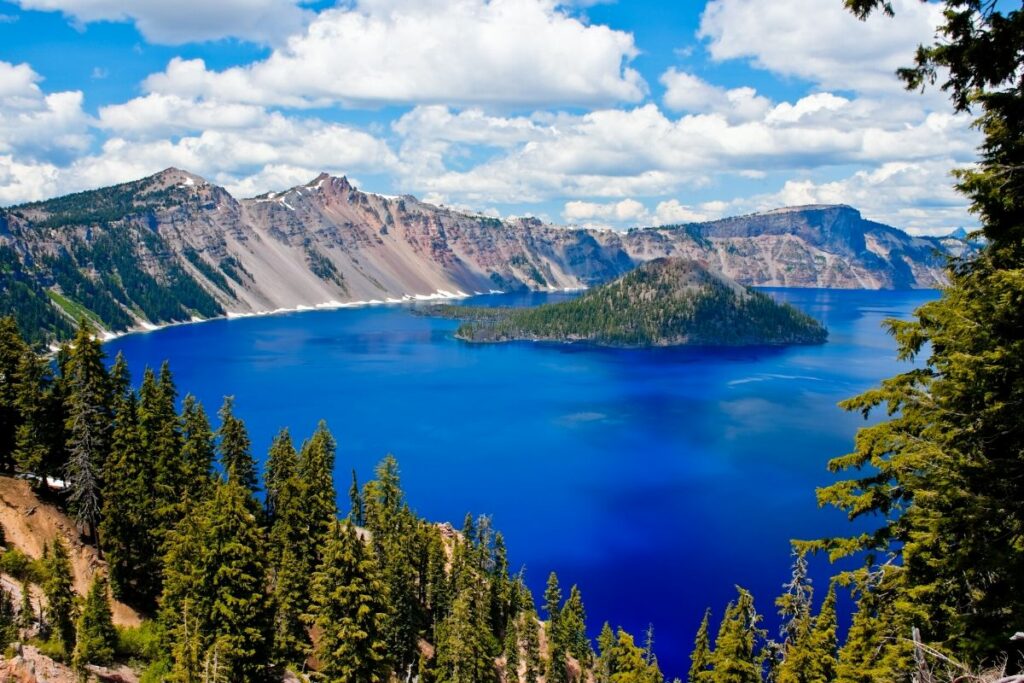
Cuyahoga Valley National Park, Ohio
Located just outside of Ohio’s largest population centers, this park encompasses beautiful forests, historic buildings, and waterfalls that border the recently rejuvenated Cuyahoga River. The park is very large and spread out, meaning that driving, as opposed to hiking, is definitely one of the best ways to experience it. You can stop by and tour historic settlements such as the Boston Mill area to learn about the role canals played in the development of Ohio.
One of the best ways to experience this park is by enjoying it from the a seat on the Cuyahoga Valley Scenic Railroad which takes you almost the entire length of the park. You can watch the landscape roll by while listening to park rangers tell you all about the history and natural wonder that abound in the park all all without without having to lift anything heavier than a glass of your favorite beverage.
There are also many easy yet still enjoyable strolls that you can take through the forests that will hardly require you to break any kind of sweat such as the
Best Time to Visit Cuyahoga Valley: April to October
How to get to Cuyahoga Valley: Cuyahoga Valley National Park is located via I-77, I-71, I-80, I-90.
Cuyahoga Valley Entrance Fee: Free
Cuyahoga Valley Official Website: Click Here
Map of Cuyahoga Valley: Download
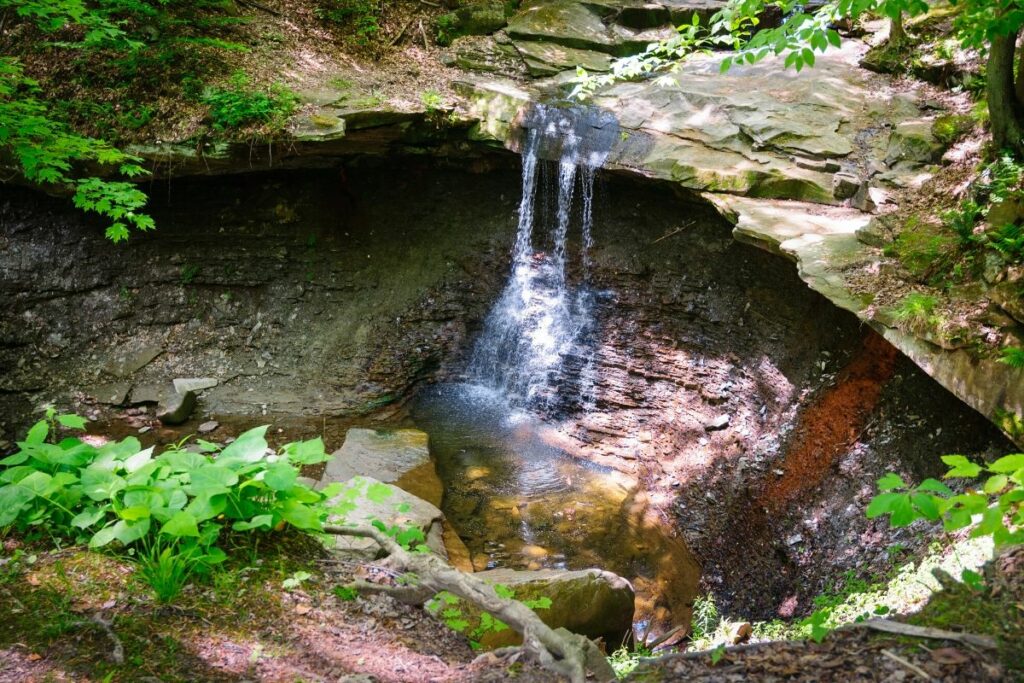
Get help planning your trip to Cuyahoga Valley National Park
Denali National Park, Alaska
The crown jewel of the Alaskan park system, Denali is home to the tallest peak in North America. It is also home to hundreds of square miles of wilderness, many of which can only be accessed on foot or in a dogsled. When the parks Canine Rangers aren’t on duty they hang out in the kennel area where you can meet them up close and even see demonstrations led by human rangers.
Aside from this program, you may be wondering how an Alaskan wilderness park could make the list of Amazin Parks for Non-Hikers. It is mostly due to the Denali bus tours, which are the only way to access parklands that are protected from private motor vehicle traffic thanks to it’s preserve status meaning driving on your own is not allowed. All of the sights that make Denali what it is can be enjoyed from the seat of one of the parks many tour vehicles and each bus comes equipped with its own naturalist narrator.
Best Time to Visit Denali: June though August
How to get to Denali: Denali is reached via the Parks Highway or via the Alaskan Railroad.
Denali Entrance Fee: $15 per person
Denali Official Website: Click Here
Map of Denali: Download
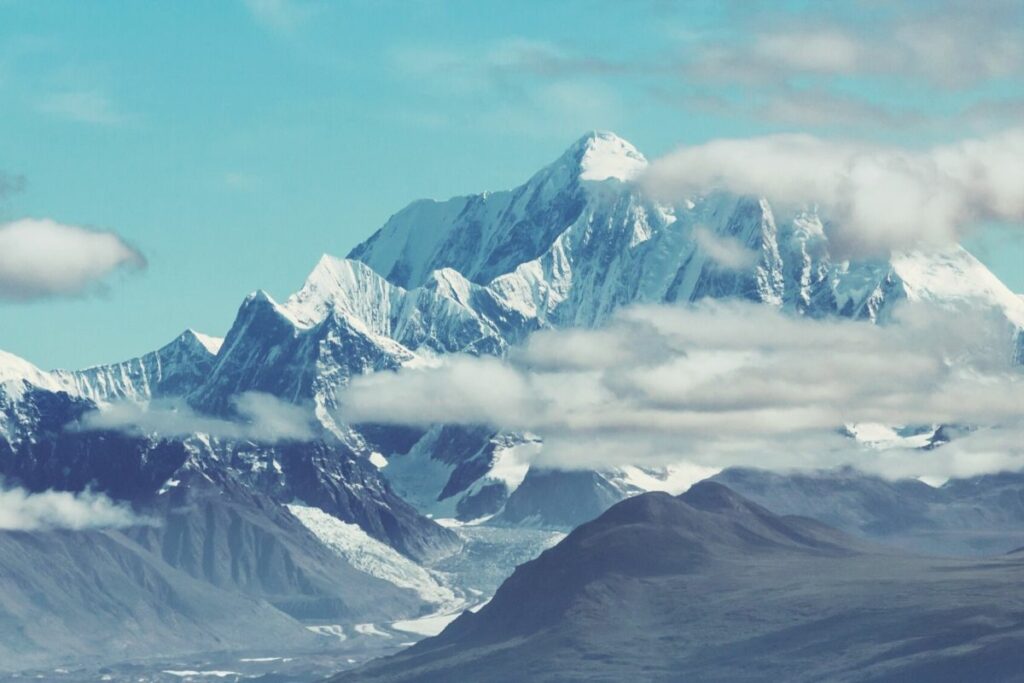
Get help planning your trip to Denali National Park
- National Parks of Alaska
- All About Denali National Park and Preserve
- How to Get to Denali National Park
- 10 Things to Know Before Visiting Denali National Park
- 8 Books to Read Before Visiting Denali National Park and Preserve
- The Ultimate Guide to Camping in Denali National Park
- Denali Road Lottery – Everything You Need to Know
Dry Tortugas National Park, Florida
Located off the tail-end of the Florida Keys, this park includes unparalleled opportunities for snorkeling and water exploration as well as tours of the Historic Fort Jefferson. One thing it isn’t home to is long, strenuous hikes.
Getting to Dry Tortugas National Park can only be done via boat or seaplane, so there is no hiking involved and actually getting to this remote location. Once there, there are few walks that would qualify as hikes due to the relatively flat and small size of the island. Opportunities to stroll through the stone arches of Fort Jefferson abound. You can also sit on the beach or take a swim among the amazing fish and aquatic life. The crystal-clear water also allows great viability, so if you prefer not to get your hair wet you can wade through the surface and catch bird-eye views of many of the park’s colorful fish.
Best Time to Visit Dry Tortugas: November through April
How to get to Dry Tortugas: Dry Tortugas National Park is located 70 miles west of Key West and is reached via boat, ferry or seaplane.
Dry Tortugas Entrance Fee: $15 per person
Dry Tortugas Official Website: Click Here
Map of Dry Tortugas: Download
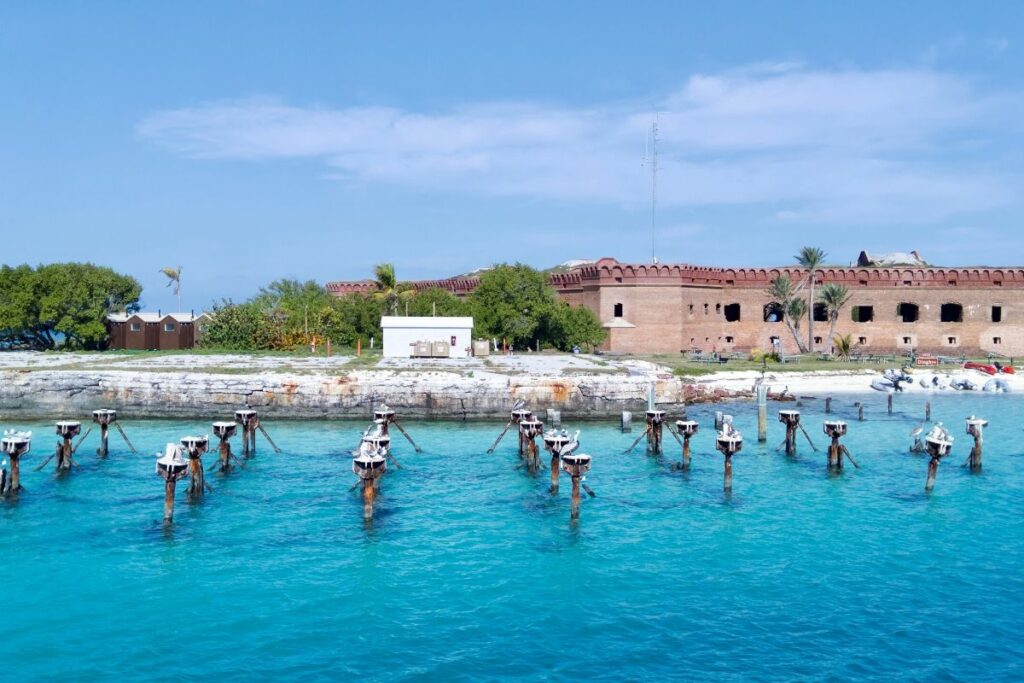
Get help planning your trip to Dry Tortugas National Park
- National Parks of Florida
- All about Dry Tortugas National Park
- The Ulitmate Guide to Camping on Dry Tortugas National Park
Grand Canyon National Park, Arizona
Theodore Roosevelt once said that the Grand Canyon “is the one site that all American’s should see” and for good reason. To stand on the edge of the canyon rim and consider the geologic processes that created create a sense of awe unlike many other sites. And because it is the one site all American’s should see, there are plenty of things for non-hikers to do.
To start, the most famous sights and vistas, like Grand Visita and Hopi Point, are all located along paved, level footpaths that are in many cases ADA accessible. They are all located along the parks shuttle stops as well, meaning that you can avoid long walks very easily. The park is also home to several visitor and interpretive centers, such as the Tusayan Museum, that help you learn about the canyon’s human and natural history. One of the parks most famous features, the Desert View Watchtower, is a great stop for non-hikers to take in the sunset. And if you’re looking to get yourself a drink, El Tovar’s balcony is a great place to enjoy a glass of something while you gaze out along the buttes and mesas.
Best Time to Visit Grand Canyon: March through May and September through November
How to get to Grand Canyon: The Grand Canyon has a north and south rim. They are not connected via a road. The South Rim is accessed vis AZ 61 and the North Rim is accessed US 89A.
Grand Canyon Entrance Fee: $35
Grand Canyon Official Website: Click Here
Map of Grand Canyon: Download
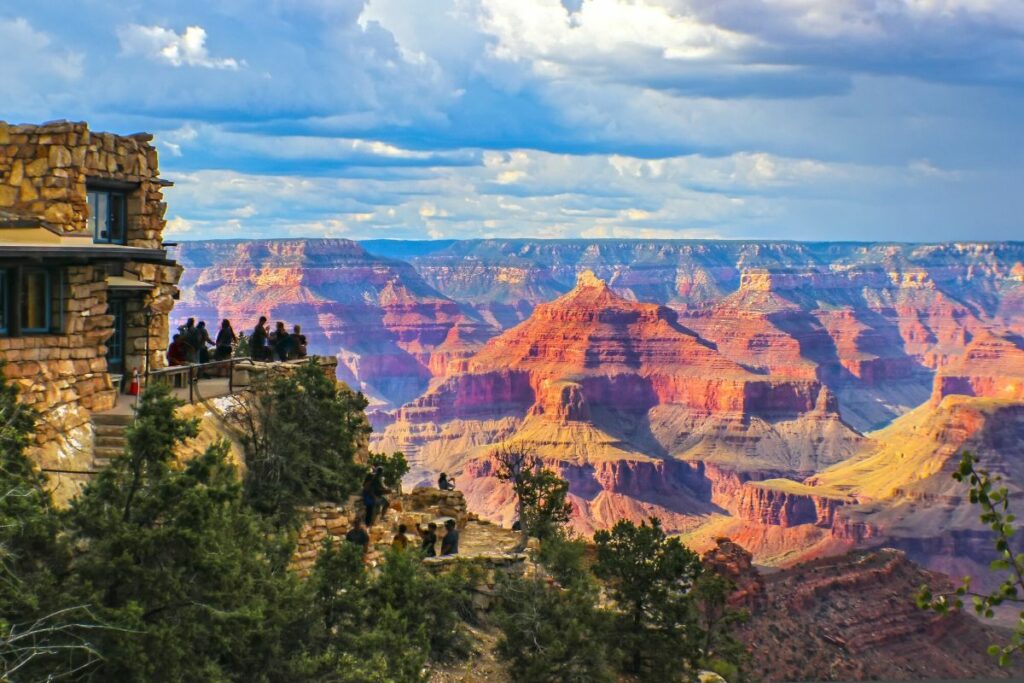
Get help planning Grand Canyon National Park Trip:
Great Smoky Mountains National Park, North Carolina/Tennessee
Americas most visited national park straddles the border between Tennessee and North Carolina. Home to majestic views, historic settlements, and a wealth of wildlife, it is one of the most amazing places that you can visit, and you don’t have to be a hiker to enjoy it.
Despite it’s rugged name, the Great Smoky Mountains is one of the best parks for road bikers in the nation. Biking the Cades Cove area, which is very difficult to get into by car, can be a great way to explore the park without having to become foot sore.
Getting into the mountainous areas can require some hiking, but there are plenty of places to enjoy forest and or meadow walks. The Tremont area is especially good and home to the park’s educational institute with plenty of nature programs that the public and participate in for free.
But no visit to this park would be complete without getting too taken some of the breathtaking views and rolling ridges that make up the area. A simple drive up to the top of Clingmans Dome will allow you an incredible vista without having to pay for it in soreness the next morning.
Best Time to Visit Great Smoky Mountains: year-round
How to get to Great Smoky Mountains: Great Smoky Mountains can be accessed from US-441 or US-321.
Great Smoky Mountains Entrance Fee: Free
Great Smoky Mountains Official Website: Click Here
Map of Great Smoky Mountains: Download
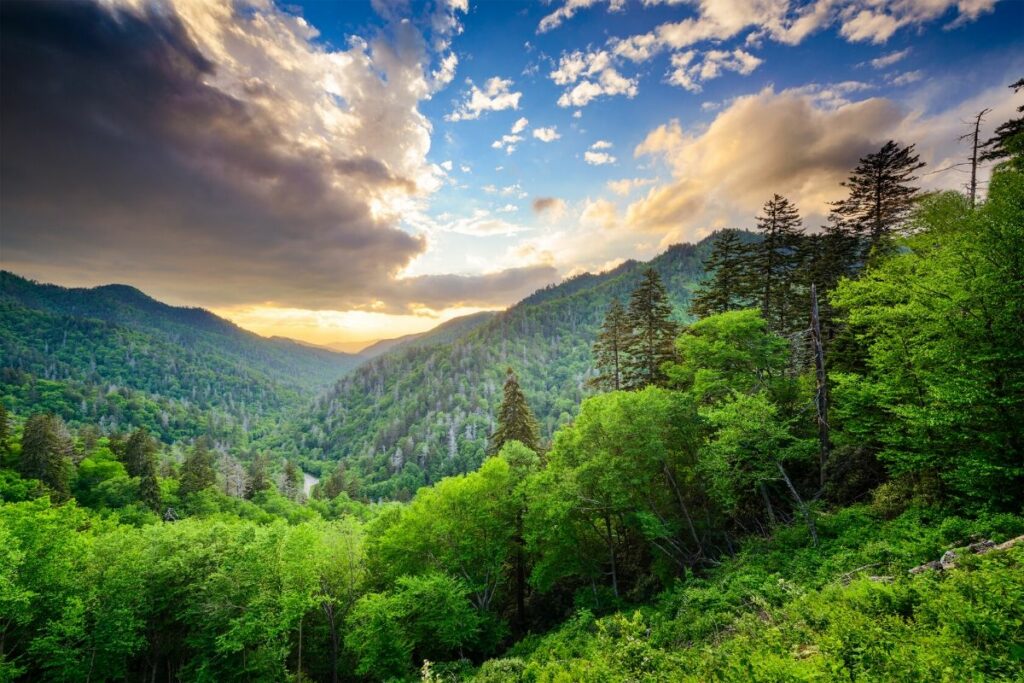
Get help planning your trip to Great Smoky Mountains National Park
- National Parks of Tennessee
- National Parks of North Carolina
- 11 Things to Know Before Visiting Great Smoky Mountains National Park
Hot Springs National Park, Arkansas
Long before the arrival of Europeans, the native peoples of the Arkansas region soaked themselves in the therapeutic, naturally heated springs. To this day, these waters continue to attract people to Hot Springs National Park.
Although there are a few hiking trails that take you into the hills where you can see naturally-occurring Hot Springs, this national park is all about relaxation and rejuvenation – not getting your 10,000 steps in! Visitor activities revolve around the bathhouses where you can soak in the mineral-rich Springwater that bubbles up from below the earth without having to walk more than a few hundred yards. The park’s boundary border of the town of Hot Springs, so travel necessities like food and accommodations are literally a couple of blocks from the park itself. Hot Springs National Park is also home to the only microbrewery that operates on parkland, meaning that everything you need for an enjoyable trip is just a few steps away from you!
Best Time to Visit Hot Springs: year-round
How to get to Hot Springs: Hot Springs National Park is located in downtown Hot Springs, Arkansas
Hot Springs Entrance Fee: Free
Hot Springs Official Website: Click Here
Map of Hot Springs: Download

Get help planning your trip to Hot Springs National Park
Joshua Tree National Park, California
The unique ecosystem where the Colorado and Mojave Deserts collide combined with incredible rock formations and the iconic a Joshua Tree’s make this a spectacular park to visit for everyone.
Joshua tree is a great park for people who would rather spend their time doing something else besides logging miles on the bottom of their boots. Like many of the other parks on this list, most of the iconic features can be reached easily or after brief walks on level trails. Visiting the Keys Ranch site provides ample opportunities to capture photos and bone up on the history of the park, and all along the roads of the park there are great places to pull out and walk amongst the iconic tree from which the park gets its name. One of the most accessible trails in the Bajada Nature Trail which tells you all about the environment that encompasses the park.
The majority of the rock features in the park are located next to pull-outs and parking areas allowing you many opportunities to explore or scramble up boulder formations without having to walk for miles first. Jumbo Rocks campground is close to many of these amazing piles and a great place to get closer to them.
Best Time to Visit Joshua Tree: March to May and October to November
How to get to Joshua Tree: Joshua Tree can be accessed via I-10 or via CA-6
Joshua Tree Entrance Fee: $30
Joshua Tree Official Website: Click Here
Map of Joshua Tree: Download
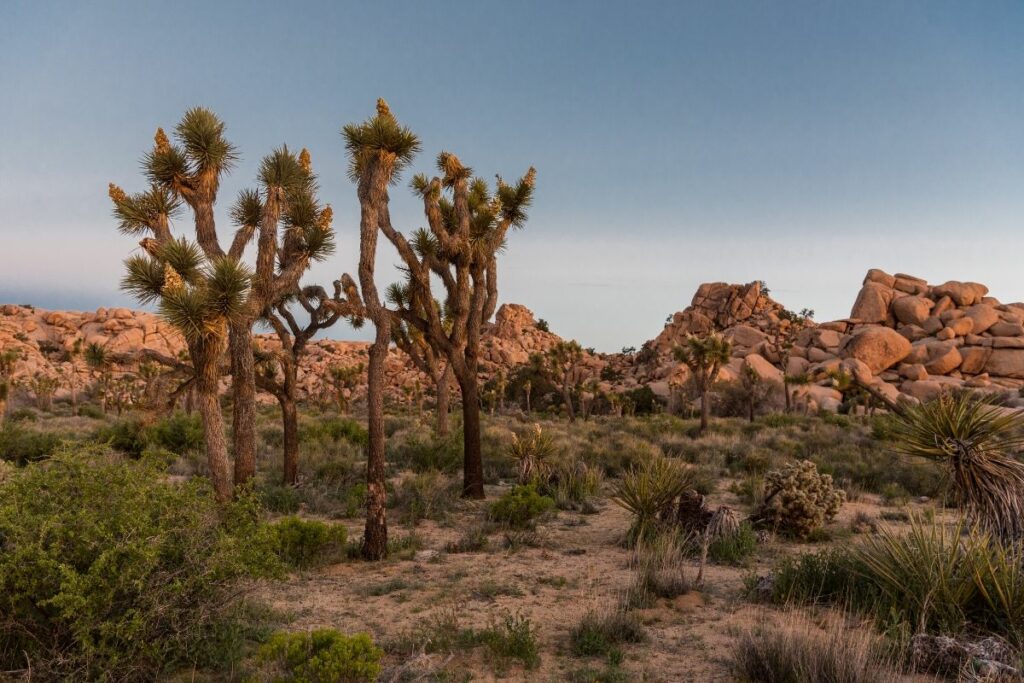
Get help planning your trip to Joshua Tree National Park
- National Parks of California
- All about Joshua Tree National Park
- One Day in Joshua Tree National Park
- 10 Things to Miss on Your First Visit to Joshua Tree National Park
- The Ultimate Guide to Camping in Joshua Tree National Park
Petrified Forest National Park, Arizona
Located in one of the lonelier corners of Arizona, this National Park encompass is one of the largest deposits of petrified wood in the United States. But rainbow-bright colors of the fossilized wood piles are just part of the parks story. Located along the original route of the famed “Mother Road” Route 66, the park has a rich history of travel as well as a legacy of making it accessible to people who come.
Petrified Forest National Park, while still having a very interesting topography, is more or less flat. There are some hilly areas, but the many of its most iconic features can be reached without having to factor in elevation gain. One of its most spectacular viewpoints, namely the Painted Desert at sunset, can be accessed easily buy a short walk to the rear of the Historic Painted Desert Inn. If you want to see petrified wood, the Crystal Forest trail is short, relatively level, and takes you through one of the park’s largest deposits.
If you don’t mind taking a stroll and can stretch your legs, the spectacular badlands formations of the Blue Mesa, you can take the short loop along the Blue Forest trail without much effort.
Best Time to Visit Petrified Forest: March to October
How to get to Petrified Forest: Petrified Forest is easily accessed from I-40.
Petrified Forest Entrance Fee: $25
Petrified Forest Official Website: Click Here
Map of Petrified Forest: Download

Get help planning your trip to Petrified Forest National Park
- National Parks of Arizona
- One Day in Petrified Forest National Park
- A Guide to Camping in the Painted Desert of Petrified Forest National Park
Shenandoah National Park, Virginia
Located just 75 minutes outside of our nation’s capital, Shenandoah national park was created out of a patchwork of land that was purchased by the national government during the 1930s and 40s. It is well known for its majestic Skyline Drive and magnificent forested areas.
Shenandoah National Park has a lot of different historic areas, original farms, and settlements that you can visit. These areas are very easy to tour and don’t require much in the way of hiking in order to enjoy. Sites like Rapidan Camp offer ample opportunities for learning about park history as well as photography.
Since most of the parks most notable locations are located along Skyline Drive, many areas and turnouts are easily accessible by car and do not require walking at all. Bikers can also travel along this road which is a popular method of seeing many of the parts of the park. This park also has dozens of opportunities to go fishing in the mountain streams the cascade down either side of the park’s higher areas.
Best Time to Visit Shenandoah: April to October
How to get to Shenandoah: Shenandoah can be accessed via I-66 and Route 340, Route 211, Route 33, and I-64 and Route-250
Shenandoah Entrance Fee: $30
Shenandoah Official Website: Click Here
Map of Shenandoah: Download
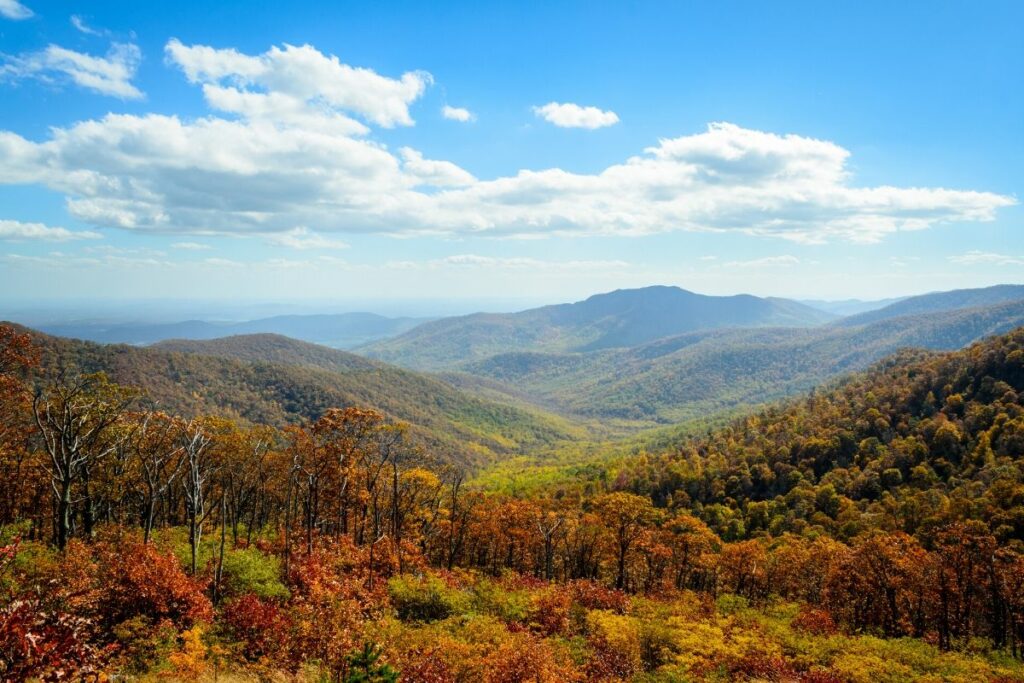
Get help planning your trip to Shenandoah National Park
- National Parks of Virginia
- Visiting Shenandoah National Park
- How to spend an Amazing Weekend in Shenandoah National Park
Theodore Roosevelt National Park, North Dakota
This hidden gem is set among the badlands of North Dakota and is home to one of the largest, and most brazen, buffalo herds in the entire national park system. If you go, you will see Bison up close and personal, but that’s just a small part of what makes this park so unique.
Theodore Roosevelt National Park has many things that make it well worth a visit. The parks association with Theodore Roosevelt and his Maltese Cross Cabin are a great place to start a visit to the southern park unit. The interesting badland formations that extend throughout the park are easily accessible from the road or a short stroll along the Ridgeline trail. Cottonwood forests, petrified wood, and river overlooks can be accessed from the park’s main road.
Also, if you’ve ever been to a National Park and had hike miles and miles in order to get to areas where wildlife congregate, then this is the place for you. The bison of Theodore Roosevelt generally come right up to you, and in many cases brush right up against your car without a second thought. You can also stop at one of the dozens and dozens of Prarie Dog towns that dot the park and listen to them chirp and shriek till your heart’s content.
Best Time to Visit Theodore Roosevelt: May through October
How to get to Theodore Roosevelt: There are three units of Teddy Roosevelt. The South Unit is accessed via I-90 and the North Unit via US-85.
Theodore Roosevelt Entrance Fee: $25
Theodore Roosevelt Official Website: Click Here
Map of Theodore Roosevelt: Download
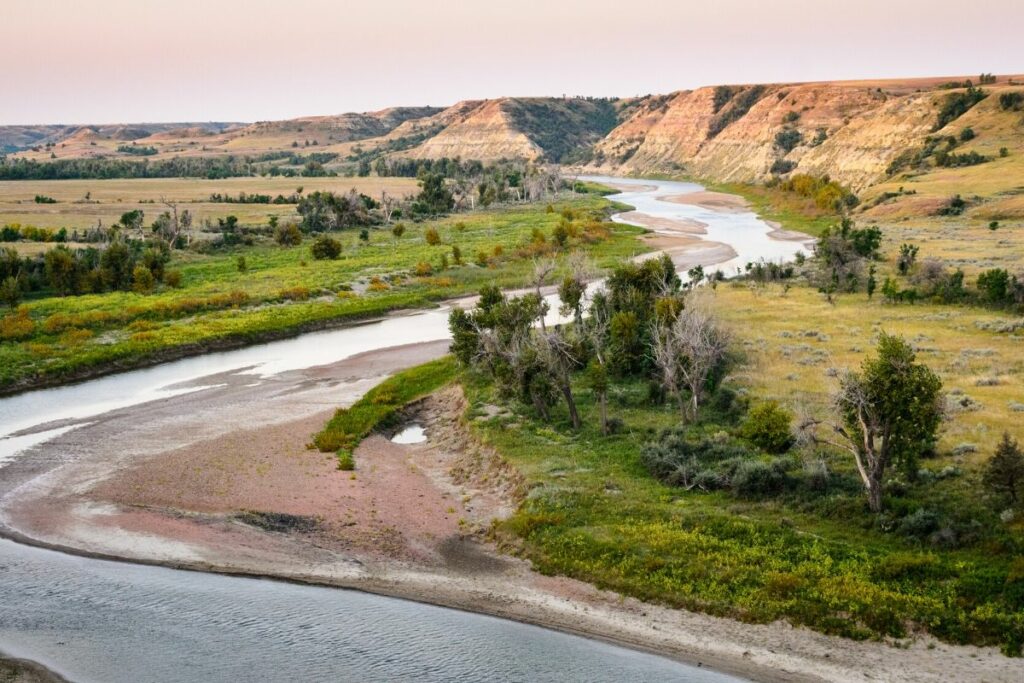
Get help planning your visit to Theodore Roosevelt National Park:
- National Parks of North Dakota
- All about Theodore Roosevelt National Park
- One Day in Theodore Roosevelt National Park
Yellowstone National Park, Wyoming/Montana/Idaho
Our nation’s first national park is home to incredible geothermal features as well as an abundance of wildlife so dense that it is sometimes referred to as the “Serengeti of North America.” A trip to Yellowstone does not have to involve an over-abundance of pedestrian activity, but only if you know what to do.
Although Yellowstone is home to many amazing hikes, all of the thermal features that make the park what it is can be found by walking along level, wheelchair accessible boardwalks. Although you may want to take a slightly longer walk here or there in order to fully enjoy views such as the Grand Prismatic Spring from up high, most of the parks thermal areas like the Norris Geiser Basin, are easy to see from the boardwalk system. If you want to see Old Faithful, why not do so from the balcony of the Old Faithful Inn instead of jostling for space along the boardwalks.
The Lamar Valley is a wide expanse of grassland that offers great wildlife viewing from the roads with minimal effort or walking required, provided you bring some binoculars to see the herds of bison and pronghorn. If you enjoy fishing or boating, Yellowstone Lake is a fantasic area to spend a day or two where you can take in the many ranger programs or just sit and enjoy the cool breezes coming off the water.
If you plan your day right, the longest hikes you’ll have are through the heavily crowded parking lots.
Best Time to Visit Yellowstone: April to September
How to get to Yellowstone: Yellowstone National Park has 5 park entrances. They are accessible by making a couple of hour detour off I-15, I-90, and I-80.
Yellowstone Entrance Fee: $35
Yellowstone Official Website: Click Here
Map of Yellowstone: Download
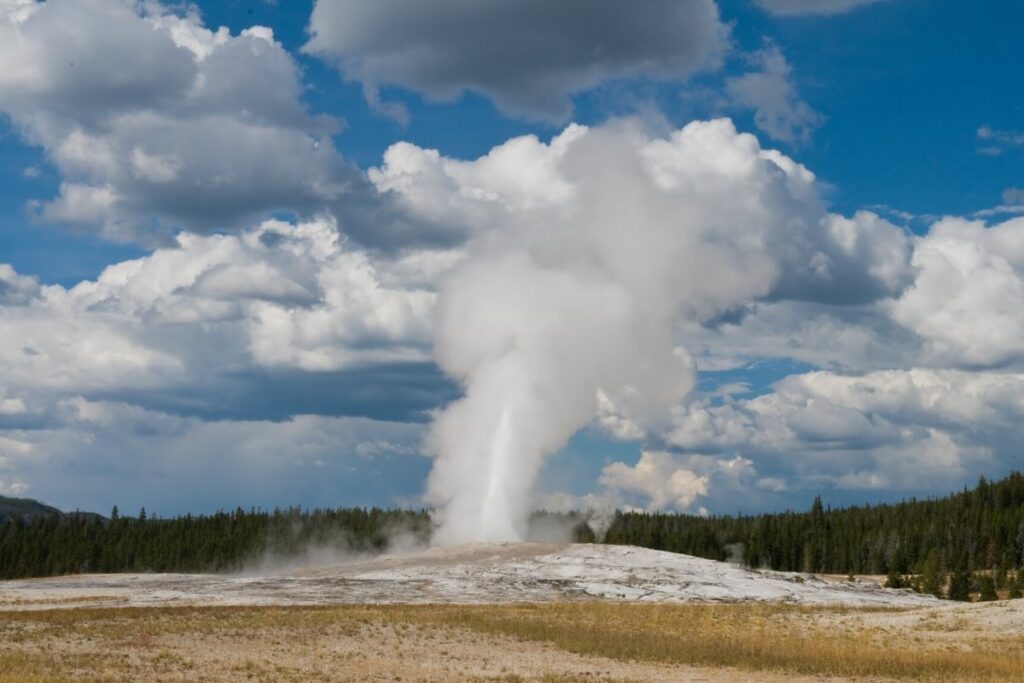
Get help planning your trip to Yellowstone National Park
- National Parks of Wyoming
- National Parks of Montana
- National Parks of Idaho
- All About Yellowstone National Park
- How to Get to Yellowstone National Park
- 10 Things to Know Before Visiting Yellowstone National Park
- 11 Books to Read Before Visiting Yellowstone National Park
- One Day in Yellowstone National Park – Yellowstone’s Grand Loop Highlights Driving Tour
- The Ultimate Guide to Camping in Yellowstone National Park
Yosemite National Park, California
A trip to Yosemite involves waterfalls, towering granite monoliths, and strolls through Sequoia groves. But it doesn’t have to involve a lot of hiking.
Driving into the valley, there are two main areas to park which both offer you access to the park’s shuttle system. From there, you can travel anywhere along the valley you would like, seeing sites such as the towering Yosemite Falls, or the view of Half Dome from Sentinel Bridge. There are many different places where a short walk can offer you even better views. Strolling through the valley meadows will give you great opportunities to see El Capitan or Cathedral Rock. You can also take a longer stroll down to Mirror Lake to really get up close and personal with the face of Half Dome. This walk is only as long as you want to make it, and along paved path.
There are also a couple of great places to visit outside of the valley. The WawonaPioneer Museum gives you an idea of what it was like to live in the wilds of Yosemite. And then, of course, there are the big trees areas, which have been recently renovated to make them even more accessible to every visitor to the park.
Best Time to Visit Yosemite: April to October
How to get to Yosemite: Yosemite National Park has five different park entrances From the east, there is Tioga Pass which can be reached via US-395. From the West, the other four entrances can be reached via CA-41, CA-140, and CA-120.
Yosemite Entrance Fee: $35
Yosemite Official Website: Click Here
Map of Yosemite: Download
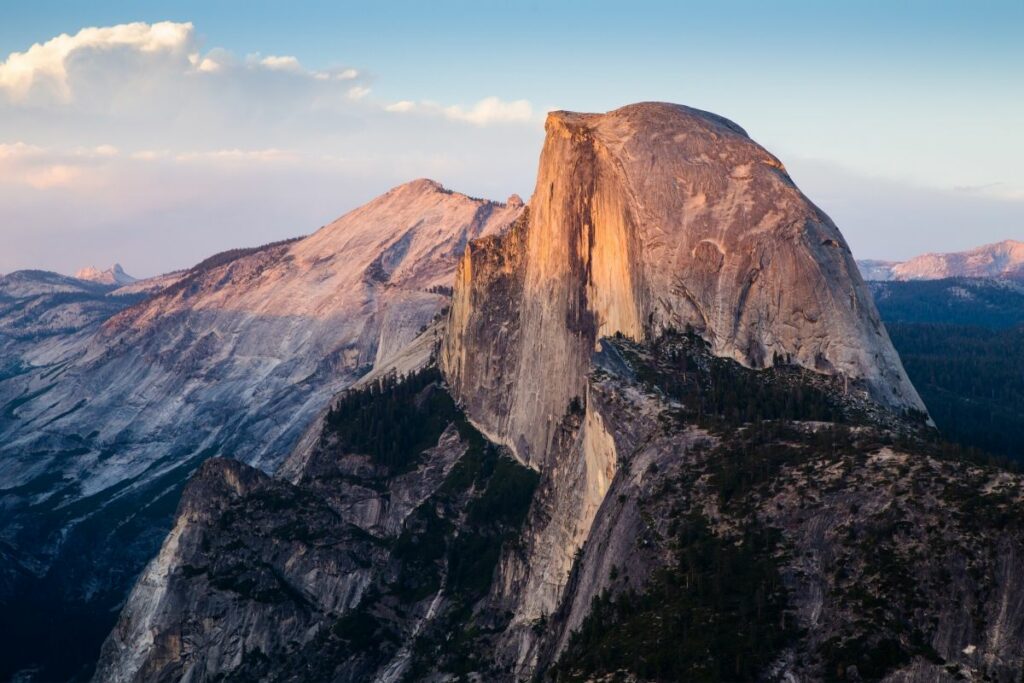
Get help planning your trip to Yosemite National Park
- National Parks of California
- 10 Books to Read Before Visiting Yosemite National Park
- One Day in Yosemite Valley
- How to make the most of a weekend in Yosemite
Pin to Share: 15 Amazing National Parks for Non-Hikers

Jennifer Melroy
Hi, I'm Jennifer!
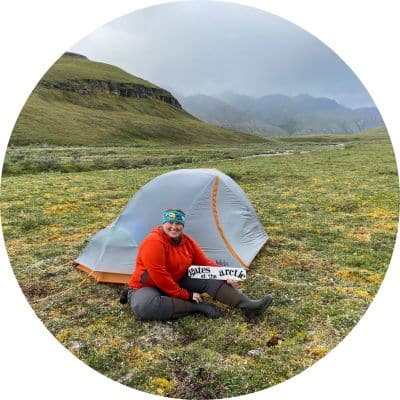
Welcome to the wonderful world of National Parks. I'm here to help you plan your NEXT amazing adventure through the United States National Parks and beyond. I want the national parks to be accessible to all.
I live in Tennessee, and when I'm home, you can find me hiking in the Smokies and the Cumberland Plateau.
58/63 National Parks
250+/423 National Park Units
Want to know more? Start Here.
Explore More
ACKNOWLEDGEMENT OF LAND
On this site, we promote travel to the United States and beyond that are the traditional lands of Indigenous and First Nations peoples.
With respect, I make a formal land acknowledgment, extending my appreciation and respect to these lands’ past and present people.
To learn more about the people who call these lands home, I invite you to explore Native Land.
DISCLAIMER
National Park Obsessed assumes no responsibility or liability for any errors or omissions in the content of this site (NationalParkObsessed.com). The information contained in this site is provided with no guarantees of completeness, accuracy, usefulness or timeliness. You are encouraged to conduct your own due diligence before acting on the information provided on this site and should not rely on the opinions expressed here.
There is an inherent risk in all outdoor recreation activities, the reader assumes all responsibility for their own personal safety.
DISCLOSURE
We are a participant in the Amazon Services LLC Associates Program, an affiliate program designed to provide a means for us to earn fees by linking to Amazon.com and affiliated sites.
Privacy Policy • About Us • Contact
Select stock photography provided depositphotos
Copyright ©2023 National Park Obsessed, LLC
Privacy Overview
Last Updated on 3 Sep 2021 by Jennifer Melroy
